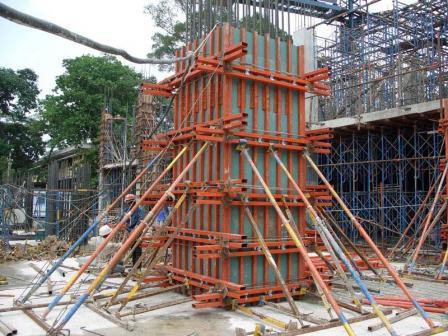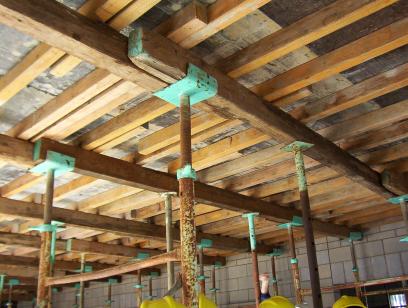The removal of formwork also called as strike-off or stripping
of formwork should be carried out only after the time when concrete has
gained sufficient strength, at least twice the stress to which the
concrete may be subjected to when the formworks are removed. It is also
necessary to ensure the stability of the remaining formwork during
formwork removal.
Special attention is required for formwork removal of flexural members such as beams and slabs. As these members are subjected to self-load as well as live load even during construction, they may deflect if the strength gained is not sufficient to handle to loads.
To estimate the strength of concrete before formwork removal, the tests on concrete cubes or cylinders should be carried out. The concrete cubes or cylinders should be prepared from the same mix as that of the structural members and cured under same circumstances of temperature and moisture as that of structural member. When it is ensured that the concrete in the structural members has gained sufficient strength to withstand the design load, only then formworks should be removed. If possible, the formworks should be left for longer time as it helps in curing.
 Generally
following values of concrete strength is considered for removal of
formwork for various types of concrete structural members.
Generally
following values of concrete strength is considered for removal of
formwork for various types of concrete structural members.
Important Note:
It is important to note that the time for formwork removal shown above in Table -2 is only when Ordinary Portland Cement is used. In normal construction process Portland Pozzolana cement is used. So, the time shown in Table-2 should be modified.
For cements other than Ordinary Portland cement, the time required for formwork removal should be as:
 During stripping of formwork, following points must be remembered:
During stripping of formwork, following points must be remembered:
Formwork Removal Time
The rate of hardening of concrete or the concrete strength depends on temperature and affects the formwork removal time. For example, time required for removal of concrete in winter will be more than time required during summer.Special attention is required for formwork removal of flexural members such as beams and slabs. As these members are subjected to self-load as well as live load even during construction, they may deflect if the strength gained is not sufficient to handle to loads.
To estimate the strength of concrete before formwork removal, the tests on concrete cubes or cylinders should be carried out. The concrete cubes or cylinders should be prepared from the same mix as that of the structural members and cured under same circumstances of temperature and moisture as that of structural member. When it is ensured that the concrete in the structural members has gained sufficient strength to withstand the design load, only then formworks should be removed. If possible, the formworks should be left for longer time as it helps in curing.

Table – 1: Strength of concrete vs. Structural Member Type & Span for Formwork Removal
Concrete Strength
|
Structural Member Type and Span
|
| 2.5 N/mm2 | Lateral parts of the formwork for all structural members can be removed |
| 70% of design strength | Interior parts of formwork of slabs and beams with a span of up to 6m can be removed |
| 85% of design strength | Interior parts of formwork of slabs and beams with a span of more than 6m can be removed |
Table – 2: Formwork Stripping Time (When Ordinary Portland Cement is used):
Type of Formwork
|
Formwork Removal Time
|
Sides of Walls, Columns and Vertical faces of beam
|
24 hours to 48 hours (as per engineer’s decision)
|
Slabs (props left under)
|
3 days
|
Beam soffits (props left under)
|
7 days
|
Removal of Props of Slabs:
| |
i) Slabs spanning up to 4.5m
|
14 days
|
ii) Slabs spanning over 4.5m
|
14 days
|
Removal of props for beams and arches
| |
i) Span up to 6m
|
14 days
|
ii) Span over 6m
|
21 days
|
It is important to note that the time for formwork removal shown above in Table -2 is only when Ordinary Portland Cement is used. In normal construction process Portland Pozzolana cement is used. So, the time shown in Table-2 should be modified.
For cements other than Ordinary Portland cement, the time required for formwork removal should be as:
- Portland Pozzolana Cement – stripping time will be 10/7 of the time stated above (Table-2)
- Low heat cement – stripping time will be 10/7 of the time stated above (Table-2)
- Rapid Hardening Cement – stripping time of 3/7 of the time stated above (Table-2) will be sufficient in all cases except for vertical sides of slabs, beams and columns which should be retained at least for 24 hours.
Formwork Removal Specification:

- Formwork should not be removed until the concrete has developed sufficiently strength to support all loads placed upon it. The time required before formwork removal depends on the structural function of the member and the rate of strength gain of the concrete. The grade of concrete, type of cement, water/cement ratio, temperature during curing etc. influence the rate of strength gain of concrete.
- The formwork parts and connections should be arranged in a way that makes formwork removal easy and simple, prevents damage to concrete and formwork panels so that it can be reused without extensive repair.
- The formwork removal procedure should be supervised by the engineer to ensure that quality of hardened concrete in structural member, i.e. it should be free from or has minimum casting defects such as honeycombing, size and shape defects etc. These defects in concrete influence the strength and stability of structure. Thus immediate repair works can be done or the members can be rejected.
- The separation of forms should not be done by forcing crowbars against the concrete. It may damage the hardened concrete. This should be achieved by using wooden wedges.
- Beam and joist bottoms should remain in place until final removal of all shoring under them are done.
- Joist forms should be designed and removed so that the shores may be removed temporarily to permit removal of joist forms but must be replaced at once. The shores and joists will be dismantled beginning from the middle of the member’s span, continuing symmetrically up the supports.
- The approval from the engineer should be obtained for the sequence and pattern of formwork removal.
No comments:
Post a Comment